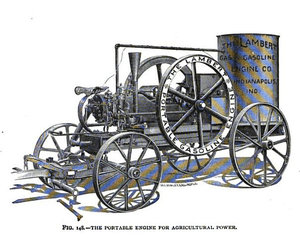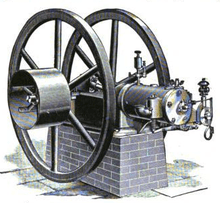Lambert Gas and Gasoline Engine Company
The Lambert Gas and Gasoline Engine Company was a company founded by John William Lambert in the later part of the nineteenth century[1][2] as part of the conglomerate of the Buckeye Manufacturing Company.[3][4][5][6]

History
Early in Lambert’s life when he was in his early twenties he had formed a partnership with his father, and under the firm style of J. W. Lambert & Company, The company was engaged in the manufacture of fork handles and spokes. In the later part of 1891 he moved to Union City, Ohio after failing in his initial attempt to make and sell "horseless carriages." There he ran an agricultural implement store, a grain elevator and a lumber yard. In 1893 Lambert came to Anderson, Indiana moving some of his machinery there. This was the nucleus for the factory plant he made in Anderson. The factory covered 6 acres (24,000 m2) of brick construction and was equipped with modern machinery of the day. The company Lambert ran made farm implement equipment and stationary gasoline engines for farms and other commercial uses. In 1893 the company was incorporated under the firm name of the Lambert Gas and Gasoline Engine Company and the Buckeye Manufacturing Company. He employed about 250 people at the time.[7]

The factory tooled up with equipment for the manufacture of automobiles in 1900 with the Lambert Gas and Gasoline Engine Company making the automobile engines and the Buckeye Manufacturing Company making the other automobile parts. The officers of the companies were B. F. Lambert as the president, George A. Lambert as the secretary, and John Lambert the treasurer and general manager. The capital stock of the companies was $100,000,[1] which would be millions in 2008 dollars.
Before the Lambert Gas and Gasoline Engine Company built automobile motors they manufactured stationary engines. A partial description of the Lambert gasoline stationary engines were described in Gas, Gasoline and Oil-engines written by Gardner Dexter Hiscox in 1910 as:
The engines built by the Lambert Gas and Gasoline Engine Company are all of the horizontal four-cycle type. They are scheduled in fifteen sizes from 1 H.P. to 40 H.P. The valves are all of the poppet type and are operated by a secondary shaft and worm reducing-gear. The exhaust valve is opened by a lever across and under the end of the cylinder, the lever having a roller riding against a cam on the secondary shaft. The exhaust chamber has a water circulation through a jacket, and the cylinder head is also jacketed and connected, so that there can be no leak into the cylinder from the water circulation.[8]
There was a "Leaflet" given out by the Lambert Gas and Gasoline Engine Company on their engines giving directions to the operator. It was a guide to their gasoline engines giving special instructions for how the internal action of the engine was performing by just the sound of how it was operating.[8]
See also
Footnotes
- Forkner, p. 452
- Netterville, vol. 2, pp. 223–224
- The Horseless Age: The Automobile Trade Magazine, p. 127
- Anderson Morning Herald, June 24, 1904, p. 3; March 14, 1905, p. 8; March 21, 1905, p. 1; April 30, 1905, p. 2; May 10, 1905, p. 1; May 24, 1905, p. 1; June 16, 1909, p. 1; November 18, 1909, p. 8; Jan. 27, 1911, p. 8; March 11, 1911, p. 8
- Anderson Sunday Herald; Anderson, Indiana; November 16, 1958
- Brandon, p. 180
- Forkner, p. 453
- Hiscox, p. 295
Primary sources
- Biography of John W. Lambert, written by his son January 25, 1935 — courtesy of the Detroit Public Library, National Automotive History Collection
- Brandon, Rodney H. Who is Who in Anderson, published privately, 1906
- Dolnar, Hugh, Automobile Trade Journal, article: The Lambert, 1906 Line of Automobiles, Chilton Company, v.10 January 1906
- Forkner, John L., History of Madison County, Indiana, New York and Chicago, The Lewis Publishing Company, 1914
- Hiscox, Gardner Dexter, Gas, Gasoline and Oil-engines, Norman W. Henley, 1910
- The Horseless Age: The Automobile Trade Magazine, The Horseless Age Company, 1902
Secondary sources
- Bailey, L. Scott, Historic Discovery: 1891 Lambert, New Claim for America's First Car, Antique Automobile magazine, Vol. 24, No. 5, Oct–Nov 1960
- David Burgess Wise, The New Illustrated Encyclopedia of Automobiles ISBN 0-7858-1106-0
- Dittlinger, Esther et al., Anderson: A Pictorial History, G. Bradley Publishing, 1990, ISBN 0-943963-16-8
- G.N. Georgano, The Beaulieu Encyclopedia of the Automobile, Taylor & Francis, 2000, ISBN 1-57958-293-1
- Huffman, Wallace Spencer, Indiana's Place in Automobile History in Indiana History Bulletin, vol 44, no. 2, Feb. 1967; Indianapolis, Indiana Historical Bureau
- Huhti, Thomas, The Great Indiana Touring Book: 20 Spectacular Auto Tours, Big Earth Publishing, 2002, ISBN 1-931599-09-2
- James, Wanda, Driving from Japan, McFarland, 2005, ISBN 0-7864-1734-X
- Kimes, Beverly Rae, Standard Catalog of American Cars, 1805-1942, Krause Publications, 1996, ISBN 0-87341-428-4
- Madden, W. C., Haynes-Apperson and America's First Practical Automobile: A History, McFarland, 2003, ISBN 0-7864-1397-2
- Scharchburg, Richard P., Carriages Without Horses: J. Frank Duryea and the Birth of the American Automobile Industry, SAE, 1993, ISBN 1-56091-380-0